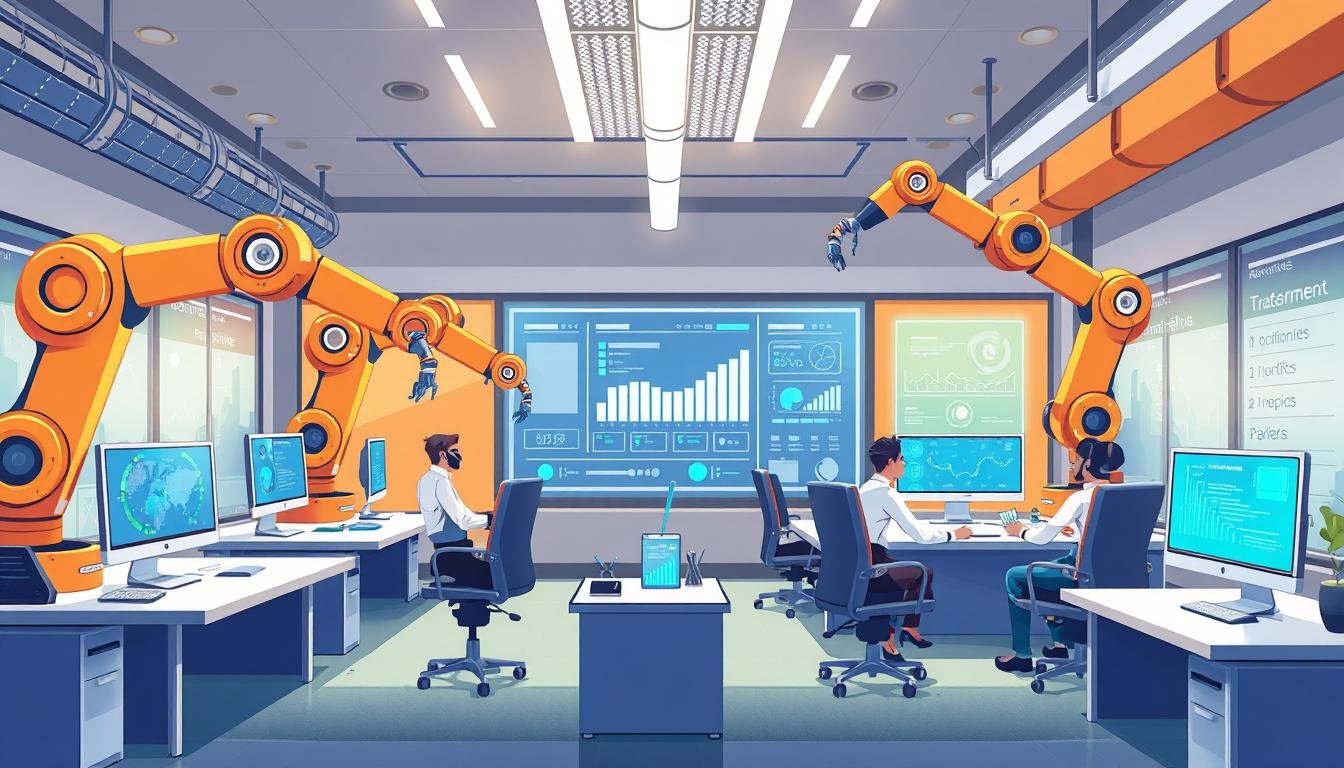The Role of Automation in Job Redesign and Task Distribution
Automation is changing how we work. As technology gets better, it’s reshaping our jobs and how tasks are done. This change is like the big shifts in the past, but now it’s more important with advanced AI and smart automation.
The McKinsey Global Institute says automation can make tasks more efficient. This leads to better productivity and less mistakes. The World Economic Forum also talks about how automation can bring new jobs and help in making jobs better in different fields.
Leading companies have shown how automation can make workplaces more efficient. Let’s explore how automation is changing jobs and tasks.
Key Takeaways
- Automation trends are significantly influencing how tasks are distributed in the workplace.
- Advanced AI systems are at the forefront of job redesign strategies, driving productivity improvements.
- Historical perspectives underscore the incremental acceptance and integration of technology.
- Research suggests potential for automation to create new opportunities and roles within industries.
- Case studies provide real-world examples of successful automation implementation.
The Impact of Automation on Workforce Transformation
Automation is changing the future of work in many industries. It uses artificial intelligence (AI) to make tasks easier, increase productivity, and cut costs. This change, brought about by technology, is changing how we see and do our jobs.
AI in the Workplace
Artificial intelligence is key in today’s workplaces. It automates tasks, analyzes big data, and helps make important decisions. Gartner says more companies are using AI to get better at work and come up with new ideas.
Labor Automation and Its Benefits
Automation offers more than just doing tasks. It works all the time, keeping productivity up. The International Federation of Robotics says automation makes work more efficient and saves money. It also cuts down on mistakes, works faster, and lets people focus on more important tasks.
Challenges in Implementing Workforce Automation
Even with its benefits, there are big hurdles to overcome. One big one is when workers worry about losing their jobs. Also, setting up new tech can be very expensive. And, people need to learn new skills to work with these systems.
Data from the Department of Labor shows these challenges. It points out the need for training and support for workers moving to automated jobs.
While the path to full automation is tough, its benefits are worth it. It can make work better and help businesses stay ahead in today’s fast world.
Job Restructuring through Intelligent Process Automation
Intelligent Process Automation (IPA) is key in modern job realignment. It makes operations smoother and more efficient. Companies use automation to change job roles, improve work processes, and stay ahead in fast-changing markets.
Key Elements of Job Restructuring
Job restructuring through IPA includes several important parts:
- Identifying repetitive tasks: Finding tasks that are the same and take too much time, perfect for automation.
- Reskilling employees: Giving training to help employees learn new skills needed in automated settings.
- Aligning automated workflows: Making sure new automated processes fit with the company’s goals and plans.
Examples of Successful Job Restructuring
Many companies have done well with job restructuring using IPA. Their stories are both motivating and full of lessons. Harvard Business Review says companies like Amazon and Toyota have used IPA to boost productivity and job happiness.
| Company | Restructuring Strategy | Outcomes |
|---|---|---|
| Amazon | Used IPA for warehousing and logistics | Speeded up deliveries, cut down on costs |
| Toyota | Applied IPA to manufacturing | Boosted quality, raised productivity |
Human-Machine Collaboration and Skill Augmentation
The growth of collaborative technology is changing many industries. It’s making the partnership between humans and machines more important. This team-up uses automation to boost human skills, making them stronger together.
Enhancing Employee Skills with Automation
Automation tools are changing the game for skill augmentation. They handle the boring tasks, freeing up people for creative and complex work. Studies from MIT show that working with machines can make workers better at their jobs. This leads to more productivity and advanced roles.
Balancing Human and Machine Roles
It’s key for companies to find a good balance between human smarts and machine speed. They need to define roles clearly and keep learning. Machines are great at handling data, but humans add creativity and empathy. This mix is essential for success.
To make the most of human-automation synergy, tasks need to be assigned wisely. This way, both humans and machines can reach their full potential.
Real-world Applications of Human-Machine Collaboration
The medical field is a great example of how humans and machines can work together. In surgeries, robots help doctors with precision, improving results and recovery times. In car making, ‘cobots’ work alongside humans, making the job safer and more efficient.
These examples show how combining human and machine skills can lead to new ideas and solutions in various fields.
Strategies for Optimized Task Distribution
Modern businesses are using new ways to improve task allocation. They make sure resources are used well and workloads are fair. By using automated systems, they make their workflow more efficient. Let’s look at how this change happens.
Automated Task Allocation Systems
Automated systems make assigning tasks easier by using smart algorithms. They watch how employees do and make sure work is spread out right. Companies like Asana and Trello lead the way with tools for a systemized workflow.
These tools cut down on mistakes and match tasks with the right person. This makes work more balanced and boosts productivity.
Workflow Optimization Techniques
To make a workflow better, you need to use certain techniques. First, map out your current workflow to find where it can be improved. Use tools like Oracle and SAP to fit these changes into your system. This makes your workflow more systemized.
Also, having a place where feedback and changes are always welcome helps a lot. This keeps your workflow efficient and effective.
- Identify key tasks: Find out which tasks are most important for your business.
- Set measurable goals: Make clear, reachable goals for each task.
- Continuous monitoring: Use data in real time to check if tasks are on track and adjust if needed.
- Utilize technology: Use automation tools for tasks to be given out consistently and efficiently.
| Company | Tool | Benefit |
|---|---|---|
| Asana | Task Management | Increased productivity through clear task assignments |
| SAP Solutions | Workflow Automation | Streamlined operations and reduced manual errors |
| Trello | Project Tracking | Improved task tracking and team collaboration |
The Role of Automation in Job Redesign and Task Distribution
Businesses are now focusing on automation strategy and task management evolution. They see how automation can make tasks easier. This leads to changes in job role adaptation. CEOs from big names like Google and Amazon talk about how automation changes daily work.
A Harvard Business School survey found 78% of companies using automation strategies. This change makes jobs more focused on strategy. It means workers need new skills for their roles.
Stanford University’s survey shows 85% of people think task management evolution is good. They believe automation will make work better and more satisfying. This shows more people are okay with a more automated work place.
| Automation Strategy | Job Role Adaptation | Task Management Evolution |
|---|---|---|
| High adoption by tech giants | Revised job descriptions | Increased productivity |
| Reported by 78% of businesses | Upskilling initiatives | Enhanced job satisfaction |
| Positive outlook by 85% | Focus on strategic tasks | Streamlined workflows |
The data is clear: a strong automation strategy changes jobs. As automation grows, so does the need for job and task management to evolve. This change is making work more efficient and engaging for employees.
Conclusion
The future of work is closely tied to automation. It’s changing how we do our jobs and how tasks are shared. This article has shown how automation is reshaping our work.
It’s key for businesses and people to understand how automation works. Using technology makes our work better and more efficient. It helps us work smarter and be more creative.
Looking to the future, automation will keep changing jobs. The Bureau of Labor Statistics says new jobs will come from tech. Experts think the next ten years will mix human skills with machines, making us more flexible.
Reports show that getting ready for automation is important. Companies and workers need to adapt to succeed in a world with more machines.








